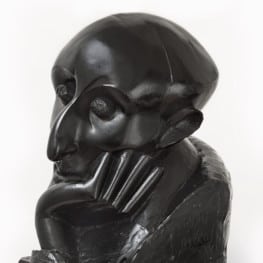Chana Orloff
1888-1968
Chana Orloff was born in 1888 in the small Ukrainian town of Staro-Konstaninov. One of nine children, she assisted in the support of her family by learning to sew and working as a seamstress. She immigrated with her family to the town of Petah-Tikva, Palestine (located just east of what would become Tel Aviv) in 1905. Orloff’s provincial upbringing in Ukraine and Palestine provided little exposure to visual art, although she was familiar with and attracted to Ukrainian folk art carvings and the decorative objects in her childhood synagogue. She remarked that the idea of becoming a sculptor came to her in a dream, in which she found herself modeling the likeness of Chaim Nachman Bialik, a famed Hebrew poet.
Within a year of this dream she left Palestine for Paris, at the time the center of the art world, and a bastion for Russian Jewish émigrés. Orloff found work sketching for Paris fashion houses upon her arrival. She enrolled in Marie Vassilieff’s Académie Russe in Montparnasse, although the education offered there was extremely casual, with little instruction and no exams. Orloff’s true education came from her submersion in the life of the Parisian avant-garde. Living in Montparnasse, she befriended and worked alongside such artists as Marc Chagall, Jacques Lipchitz, Amadeo Modigliani and Chaim Soutine. She frequented the famed artists’ studios/residences known as La Ruche (The Beehive), and became an habitué of Café Flor and La Coupole. Five years after her arrival, she was firmly ensconced as a member of the School of Paris, and counted among her models such writers as Pierre Mac Orlan and Anais Nin, as well as many of her artist peers.
Orloff’s early sculptures were carved from wood, the material with which she was most familiar from her childhood. She explored Cubist and African techniques, and from the outset, her art was characterized by smooth surfaces and a lyrical, fluid composition, evoking comparisons to the sculpture of Constantin Brancusi and Elie Nadelman, two fellow émigrés working in Paris. While Orloff’s sculptures share certain qualities with both artists (with Brancusi, the streamlining of form and integration of African influences; with Nadelman, references to classical art and an elegant whimsicality), it is indisputably her own. Orloff’s sculptures are marked by a seeming contradiction. Her subjects create a delicate, soft impression while simultaneously announcing themselves as substantive objects with a definite weight and form.


